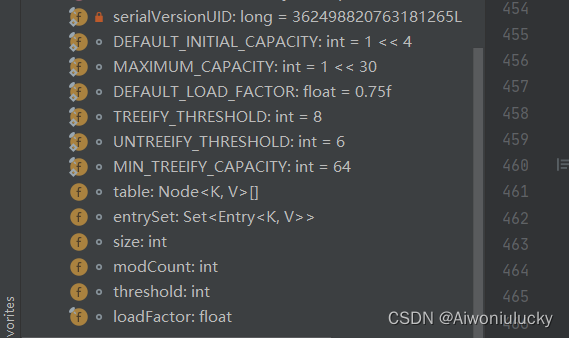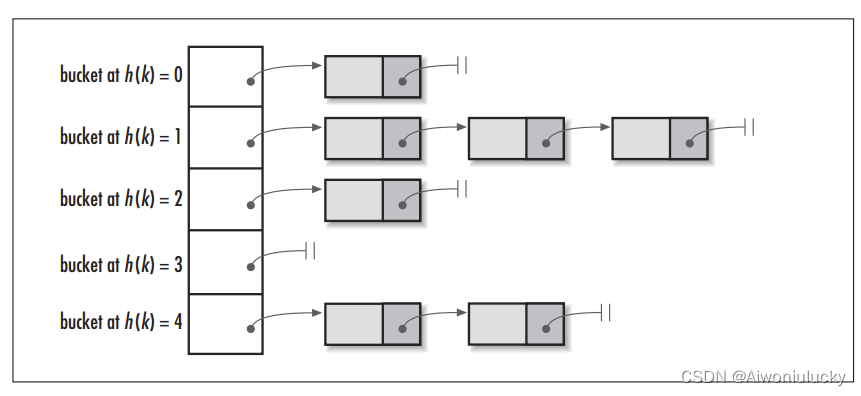-
【JavaEE】HashMap
一、一些HashMap的成员变量
 其中:
其中:
size表示了map中的键值对个数/** * The number of key-value mappings contained in this map. */ transient int size;- 1
- 2
- 3
- 4
loadFactor表示装载因子,用来衡量HashMap满的程度。loadFactor的默认值为0.75f。
/** * The load factor for the hash table. * * @serial */ final float loadFactor;- 1
- 2
- 3
- 4
- 5
- 6
threshold:临界值,当实际KV个数超过threshold时,HashMap会将容量扩容,threshold=容量*装载因子
/** * The next size value at which to resize (capacity * load factor). * * @serial */ // (The javadoc description is true upon serialization. // Additionally, if the table array has not been allocated, this // field holds the initial array capacity, or zero signifying // DEFAULT_INITIAL_CAPACITY.) int threshold;- 1
- 2
- 3
- 4
- 5
- 6
- 7
- 8
- 9
- 10
capacity容量:默认最小容量是16.
/** * The default initial capacity - MUST be a power of two. */ static final int DEFAULT_INITIAL_CAPACITY = 1 << 4; // aka 16- 1
- 2
- 3
- 4
1.1 capaticty和size的区别
如下所示测试代码,测试map的size和capacity
public static void main(String[] args) throws NoSuchMethodException, InvocationTargetException, IllegalAccessException { HashMap<String, String> map = new HashMap<String, String>(); map.put("test", "123"); Class mapD = map.getClass(); Method method = mapD.getDeclaredMethod("capacity"); method.setAccessible(true); System.out.println("capacity=" + method.invoke(map)); System.out.println("size=" + map.size()); }- 1
- 2
- 3
- 4
- 5
- 6
- 7
- 8
- 9
- 10
- 11
输出:

因此capaticty: 表示最多能装多少;size:表示已经装了多少。为什么初始化容量设置成16,因为按位运算快。也可以在初始化的时候,指定map容量大小,会默认找到比他大且离他最近的一个2的n次方。如下:
HashMap<String, String> map = new HashMap<String, String>(7); Class mapD = map.getClass(); Method method = mapD.getDeclaredMethod("capacity"); method.setAccessible(true); System.out.println("capacity=" + method.invoke(map)); System.out.println("size=" + map.size());- 1
- 2
- 3
- 4
- 5
- 6
输出:

初始化指定的是9的化,输出就是16.1.2 HashMap扩容机制
当HashMap中的元素个数(size)超过临界值(threshold)时就会自动扩容。
HashMap<String, String> map = new HashMap<String, String>(7); Class mapD = map.getClass(); Method method = mapD.getDeclaredMethod("capacity"); method.setAccessible(true); System.out.println("before capacity=" + method.invoke(map)); System.out.println("before size=" + map.size()); System.out.println("==============================================="); map.put("test1", "123"); map.put("test2", "123"); map.put("test3", "123"); map.put("test4", "123"); map.put("test5", "123"); map.put("test6", "123"); map.put("test7", "123"); System.out.println("After capacity=" + method.invoke(map)); System.out.println("After size=" + map.size());- 1
- 2
- 3
- 4
- 5
- 6
- 7
- 8
- 9
- 10
- 11
- 12
- 13
- 14
- 15
- 16
- 17
- 18
输出结果为:

触发扩容时机:
当map的size > capacity * 0.75 就会触发扩容。上面例子,就是 size > 8*0.75 (loadFactor乘capacity),就会触发扩容,容量变为16。loadFactor乘capacity也就是阈值。二、HashMap中hash方法的原理
Hash,一般翻译做“散列”,也有直接音译为“哈希”的,就是把任意长度的输入,通过散列算法,变换成固定长度的输出,该输出就是散列值。
hashMap数据结构

-
相关阅读:
vue2添加自定义节流指令
minio 支持object搜索方案
NB6L295M STM32 GD32 IO模拟驱动设计
华为OD机试 - 根据某条件聚类最少交换次数 - 滑动窗口(Java 2023 B卷 100分)
刷题记录:牛客NC20471[ZJOI2007]棋盘制作
java开发工具MyEclipse 中实体关系设计器介绍
确保使用正确的CSI提交HW问题
一小时快速上手win10 docker 、vscode、MobaXterm、git协作开发
Vue2电商前台项目——完成Home首页模块业务
第十四届蓝桥杯模拟赛第一期试题与题解Java
- 原文地址:https://blog.csdn.net/Javaer000/article/details/126674366
